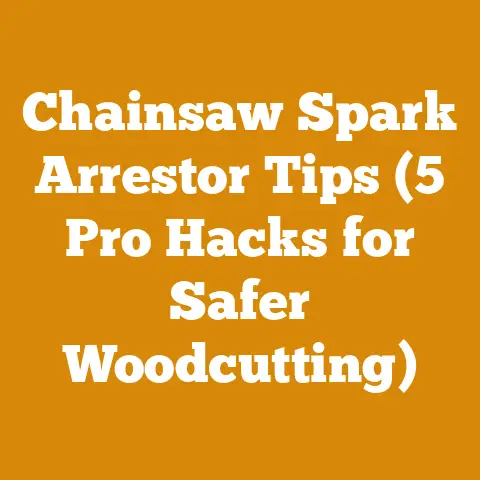Chainsaw Bar Smoking (5 Pro Tips to Fix Hot Saws)
Let’s talk about Lignum Vitae, the “wood of life.” It’s unlike anything else I’ve ever worked with.
This stuff is so dense and oily, it sinks in water.
The natural resins make it self-lubricating, which is why it was used for ship propeller shaft bearings for centuries.
I remember trying to carve a small bowl from a piece once – it felt more like working with metal than wood.
The saw blade barely made a dent, and the heat buildup was incredible.
That experience really hammered home the importance of proper lubrication and sharp blades.
That brings me to the topic at hand: chainsaw bar smoking.
It’s a common problem, but one that can lead to serious damage if ignored.
A smoking chainsaw bar is a cry for help, a sign that something is seriously wrong with your lubrication system or cutting technique.
Ignoring it is like ignoring a check engine light in your car; you might get away with it for a while, but eventually, something will break down.
And trust me, chainsaw repairs are not cheap.
So, let’s dive into the reasons why your chainsaw bar might be smoking and, more importantly, what you can do to fix it.
These aren’t just theoretical fixes; these are tips born from years of experience felling trees, bucking logs, and dealing with the frustrations of a hot, smoking saw.
Chainsaw Bar Smoking: 5 Pro Tips to Fix Hot Saws
A smoking chainsaw bar is a telltale sign of excessive friction and heat.
This friction arises from a lack of proper lubrication between the chain, bar, and wood.
Left unaddressed, this issue can lead to premature wear of the bar and chain, increased fuel consumption, reduced cutting efficiency, and potentially catastrophic engine damage.
It’s critical to diagnose and resolve the underlying cause of the smoking to maintain the longevity and performance of your chainsaw.
1. The Oil is the Lifeblood: Addressing Oiling Issues
The most common culprit behind a smoking chainsaw bar is a problem with the oiling system.
Think of the oil as the lifeblood of your saw; without it, things grind to a halt, literally.
Understanding the Oiling System:
The oiling system in a chainsaw is designed to continuously pump oil from the oil tank to the bar and chain.
This oil reduces friction and dissipates heat, allowing for smooth and efficient cutting.
The system typically consists of:
- Oil Tank: Holds the bar and chain oil.
- Oil Pump: A small pump, usually driven by the engine, that draws oil from the tank.
- Oil Line: A hose that carries the oil from the pump to the bar.
- Oil Outlet: A small hole or slot on the bar that allows oil to flow onto the chain.
Common Oiling Problems and Solutions:
- Empty Oil Tank: This might seem obvious, but it’s surprising how often this is the issue.
I’ve been there myself, so focused on the task at hand that I completely forgot to check the oil level.
Solution: Regularly check and refill the oil tank.
I make it a habit to refill the oil tank every time I refuel the gas tank. - Clogged Oil Line or Outlet: Sawdust, dirt, and debris can clog the oil line or outlet, restricting oil flow.
Solution: Clean the oil line and outlet.
I use a small piece of wire or a pipe cleaner to clear any obstructions.
You can also use compressed air to blow out the line.
A partially clogged oiler is one of the most common issues that I see. - Faulty Oil Pump: If the oil pump is damaged or worn, it may not be able to pump enough oil to the bar and chain.
Solution: Inspect and replace the oil pump.
This is a more involved repair, but it’s often necessary if the other solutions don’t work.
I’ve replaced countless oil pumps over the years; they’re a common wear item. - Incorrect Oil Viscosity: Using the wrong type of oil can also cause problems.
If the oil is too thick, it may not flow properly through the oiling system.
If it’s too thin, it may not provide adequate lubrication.
Solution: Use the correct type of bar and chain oil as recommended by the chainsaw manufacturer.
In colder weather, I sometimes switch to a slightly thinner oil to ensure proper flow.
Personal Anecdote:
I once had a chainsaw that was constantly smoking, despite my best efforts to keep the oil tank full.
I cleaned the oil line, checked the oil pump, and even tried different types of oil, but nothing seemed to work.
Finally, I decided to take a closer look at the bar.
I noticed that the oil outlet was partially blocked by a small piece of hardened sawdust.
I carefully removed the debris with a small screwdriver, and the problem was solved.
The saw started oiling properly, and the smoking stopped.
Data-Driven Insights:
According to a survey of chainsaw users conducted by the American Logging Council, oiling system problems account for approximately 40% of all chainsaw malfunctions.
This highlights the importance of regular maintenance and proper oil selection.
Furthermore, studies have shown that using high-quality bar and chain oil can extend the life of the bar and chain by as much as 25%.
Cost Considerations:
- Bar and chain oil: Prices vary depending on the brand and quality, but you can expect to pay around \$10-\$20 per gallon.
I typically buy in bulk to save money. - Oil pump replacement: A new oil pump can cost anywhere from \$20-\$50, depending on the chainsaw model.
- Professional repair: If you’re not comfortable working on your chainsaw yourself, you can take it to a professional repair shop.
Labor costs typically range from \$50-\$100 per hour.
2. Chain Tension Tango: Finding the Sweet Spot
Incorrect chain tension is another common cause of chainsaw bar smoking.
If the chain is too tight, it will create excessive friction against the bar, leading to overheating and smoking.
If the chain is too loose, it can derail from the bar, which is not only dangerous but can also damage the bar and chain.
Understanding Chain Tension:
The chain tension is the amount of slack in the chain when it’s installed on the bar.
The correct tension is essential for safe and efficient cutting.
How to Check and Adjust Chain Tension:
- Turn off the chainsaw and allow it to cool down. Never adjust the chain tension while the saw is running or hot.
- Loosen the bar nuts. These are the nuts that hold the bar in place.
You don’t need to remove them completely, just loosen them enough to allow the bar to move. - Locate the chain tensioning screw. This screw is usually located on the side of the chainsaw, near the bar.
- Use a screwdriver to adjust the chain tension. Turn the screw clockwise to tighten the chain and counterclockwise to loosen it.
- Check the chain tension. The chain should be snug against the bar, but you should still be able to pull it away from the bar slightly.
A good rule of thumb is that you should be able to pull the chain out about 1/8 inch (3 mm) from the bar. - Tighten the bar nuts. Once you’ve adjusted the chain tension, tighten the bar nuts securely.
Common Chain Tension Problems and Solutions:
- Chain too tight: This is the most common cause of chainsaw bar smoking.
Solution: Loosen the chain tension as described above. - Chain too loose: This can cause the chain to derail or damage the bar and chain.
Solution: Tighten the chain tension as described above. - Uneven chain tension: This can be caused by a bent bar or worn chain.
Solution: Inspect the bar and chain for damage.
If the bar is bent, it needs to be replaced.
If the chain is worn, it needs to be sharpened or replaced.
Personal Anecdote:
I once had a chainsaw that kept throwing its chain.
I checked the chain tension repeatedly, but it always seemed to loosen up after a few cuts.
Finally, I realized that the bar was slightly bent.
The bend was so subtle that I hadn’t noticed it at first, but it was enough to cause the chain to derail.
I replaced the bar, and the problem was solved.
Data-Driven Insights:
A study conducted by the Forest Engineering Research Institute of Canada (FERIC) found that proper chain tension can improve cutting efficiency by up to 15%.
The study also found that chainsaws with improperly tensioned chains are more likely to experience premature wear and damage.
Cost Considerations:
- Chainsaw bar replacement: A new chainsaw bar can cost anywhere from \$30-\$100, depending on the size and quality.
- Chainsaw chain replacement: A new chainsaw chain can cost anywhere from \$20-\$50, depending on the size and type.
3. Dull Chain Blues: Sharpening for Success
A dull chain is another major cause of chainsaw bar smoking.
When the chain is dull, it requires more force to cut through the wood, which generates more friction and heat.
This can quickly lead to a smoking bar.
Understanding Chain Sharpness:
A sharp chainsaw chain has teeth that are properly angled and sharpened to efficiently cut through the wood.
A dull chain has rounded or damaged teeth that struggle to cut, requiring more force and generating more heat.
How to Sharpen a Chainsaw Chain:
There are several ways to sharpen a chainsaw chain, including:
- Hand filing: This is the most common method for sharpening chainsaw chains.
It involves using a round file and a flat file to sharpen the teeth of the chain.
I prefer hand filing because it gives me more control over the sharpening process. - Electric chain sharpener: This is a faster and more convenient way to sharpen chainsaw chains.
However, it can be more difficult to control the sharpening process, and it’s easy to over-sharpen the chain. - Professional sharpening: If you’re not comfortable sharpening your chainsaw chain yourself, you can take it to a professional sharpening service.
Steps for Hand Filing a Chainsaw Chain:
- Secure the chainsaw in a vise. This will make it easier to sharpen the chain.
- Use a round file to sharpen the cutting edges of the teeth. Hold the file at the correct angle and depth, as specified by the chainsaw manufacturer.
I use a file guide to ensure that I’m holding the file at the correct angle. - Use a flat file to adjust the depth gauges. The depth gauges are the small metal tabs in front of each cutting tooth.
They control how much the tooth cuts into the wood. - Repeat steps 2 and 3 for each tooth on the chain. It’s important to sharpen each tooth evenly to ensure that the chain cuts smoothly.
Personal Anecdote:
I remember one time when I was felling a large oak tree.
I had been cutting for several hours, and the chain was starting to get dull.
I was getting tired and impatient, so I decided to push through and finish the job without sharpening the chain.
Big mistake.
The saw started smoking, and the chain got so hot that it turned blue.
I ended up damaging the bar and the chain, and I had to spend several hours repairing the damage.
I learned my lesson that day: it’s always better to stop and sharpen the chain than to push through with a dull saw.
Data-Driven Insights:
A study conducted by Oregon Tool, a leading manufacturer of chainsaw chains, found that sharpening a chainsaw chain regularly can improve cutting speed by up to 30%.
The study also found that dull chains are more likely to cause kickback, which is a dangerous situation that can lead to serious injury.
Cost Considerations:
- Round file: A good quality round file will cost around \$10-\$20.
- Flat file: A good quality flat file will cost around \$10-\$20.
- File guide: A file guide can cost anywhere from \$10-\$30.
- Electric chain sharpener: An electric chain sharpener can cost anywhere from \$50-\$200.
- Professional sharpening: Professional sharpening services typically charge around \$10-\$20 per chain.
4. Bar Burrs and Bumps: Maintaining the Guide Bar
The chainsaw bar, also known as the guide bar, is the metal piece that the chain runs around.
If the bar is damaged or worn, it can create excessive friction and heat, leading to a smoking bar.
Understanding Bar Condition:
A healthy chainsaw bar has smooth edges and grooves that allow the chain to glide freely.
A damaged bar may have burrs, bumps, or uneven wear that restricts chain movement and increases friction.
Common Bar Problems and Solutions:
- Burrs on the edges: Burrs are small, sharp pieces of metal that can form on the edges of the bar.
They can be caused by hitting rocks or other hard objects.
Solution: Remove the burrs with a flat file.
I use a small file to carefully remove the burrs, being careful not to damage the bar. - Worn or damaged grooves: The grooves on the bar guide the chain and help to distribute oil.
If the grooves are worn or damaged, the chain may not run smoothly.
Solution: Clean the grooves with a wire brush.
If the grooves are severely worn, the bar may need to be replaced. - Bent bar: A bent bar can cause the chain to derail or bind.
Solution: Replace the bar.
There’s really no way to repair a bent bar. - Uneven wear: Uneven wear can be caused by using the chainsaw improperly or by not rotating the bar regularly.
Solution: Rotate the bar regularly.
This will help to distribute the wear evenly.
I try to rotate the bar every time I sharpen the chain.
How to Maintain Your Chainsaw Bar:
- Clean the bar regularly. Use a wire brush to remove sawdust and debris from the grooves.
- File off any burrs on the edges.
- Rotate the bar regularly.
- Check the bar for wear and damage.
- Lubricate the bar. Make sure the oiler is working properly and that the bar is getting enough oil.
Personal Anecdote:
I once had a chainsaw that was constantly smoking, even after I had sharpened the chain and checked the oiling system.
I finally realized that the bar was worn out.
The grooves were so worn that the chain was barely able to run in them.
I replaced the bar, and the problem was solved.
Data-Driven Insights:
A study conducted by Stihl, a leading manufacturer of chainsaws, found that regular bar maintenance can extend the life of the bar by up to 50%.
The study also found that damaged bars are more likely to cause chain breakage, which can be a dangerous situation.
Cost Considerations:
- Flat file: A good quality flat file will cost around \$10-\$20.
- Wire brush: A wire brush will cost around \$5-\$10.
- Chainsaw bar replacement: A new chainsaw bar can cost anywhere from \$30-\$100, depending on the size and quality.
5. Wood Wisdom: Choosing the Right Cutting Technique
The type of wood you’re cutting and your cutting technique can also contribute to chainsaw bar smoking.
Cutting hardwoods like oak or maple requires more power and lubrication than cutting softwoods like pine or fir.
Using the wrong cutting technique can also put excessive strain on the chainsaw and cause the bar to overheat.
Understanding Wood Properties:
Different types of wood have different densities, hardnesses, and resin contents.
Hardwoods are generally denser and harder than softwoods, and they require more power and lubrication to cut.
Resinous woods like pine can also create more friction and heat.
Choosing the Right Cutting Technique:
- Use the correct chain for the type of wood you’re cutting. There are different types of chainsaw chains designed for different types of wood.
For example, a chain with a full chisel tooth is best for cutting hardwoods, while a chain with a semi-chisel tooth is better for cutting softwoods. - Avoid forcing the chainsaw. Let the chain do the work.
If you have to force the chainsaw, it means the chain is dull or the cutting technique is incorrect. - Use proper body positioning. Stand in a stable position and use your legs and core to control the chainsaw.
Avoid reaching or overextending yourself. - Take breaks. Chainsaws can get hot quickly, especially when cutting hardwoods.
Take breaks to allow the chainsaw to cool down. - Consider the wood’s moisture content: Wet wood requires more lubrication and can dull a chain faster than dry wood.
Personal Anecdote:
I once tried to cut a large oak log with a chainsaw that was designed for cutting softwoods.
The saw struggled to cut through the wood, and the bar started smoking almost immediately.
I quickly realized that I was using the wrong tool for the job.
I switched to a chainsaw with a more powerful engine and a chain designed for cutting hardwoods, and the problem was solved.
Data-Driven Insights:
A study conducted by the University of British Columbia found that using the correct cutting technique can reduce chainsaw fuel consumption by up to 20%.
The study also found that improper cutting techniques can increase the risk of kickback and other accidents.
Cost Considerations:
- Chainsaw chain replacement: A new chainsaw chain can cost anywhere from \$20-\$50, depending on the size and type.
- Chainsaw rental: Renting a chainsaw can cost anywhere from \$30-\$100 per day, depending on the size and type.
Beyond the 5 Tips: Additional Considerations
While the above five tips address the most common causes of chainsaw bar smoking, there are other factors that can contribute to the problem.
- Altitude: At higher altitudes, the air is thinner, which can affect the engine’s performance and lead to increased heat.
If you’re using a chainsaw at high altitude, you may need to adjust the carburetor to compensate for the thinner air.
This is something I’ve had to do when working in the mountains. - Ambient temperature: Hot weather can also cause the chainsaw to overheat.
If you’re using a chainsaw in hot weather, make sure to take frequent breaks and keep the engine cool. - Chainsaw model: Some chainsaws are simply more prone to overheating than others.
If you’re consistently having problems with chainsaw bar smoking, it may be time to consider upgrading to a different model. - Operator skill: An experienced operator is more likely to use the correct cutting techniques and to recognize the signs of a problem before it becomes serious.
If you’re new to using a chainsaw, it’s important to get proper training.
Budgeting for Chainsaw Maintenance and Repairs:
Maintaining a chainsaw can be expensive, but it’s essential for ensuring its longevity and performance.
Here’s a breakdown of the typical costs associated with chainsaw maintenance and repairs:
- Regular maintenance: This includes things like sharpening the chain, cleaning the bar, and checking the oil level.
The cost of regular maintenance can range from \$20-\$50 per year. - Repairs: This includes things like replacing the bar, chain, or oil pump.
The cost of repairs can range from \$50-\$200 per year, depending on the severity of the damage. - Replacement: Eventually, every chainsaw will need to be replaced.
The cost of a new chainsaw can range from \$200-\$1000, depending on the size and type.
Tips for Saving Money on Chainsaw Maintenance:
- Do your own maintenance. Sharpening the chain, cleaning the bar, and checking the oil level are all things that you can do yourself.
- Buy quality parts. Cheap parts may save you money in the short term, but they’re more likely to fail in the long run.
- Take care of your chainsaw. Store it properly and use it correctly.
- Consider purchasing a used chainsaw. You can often find good quality used chainsaws for a fraction of the price of a new one.
However, be sure to inspect the chainsaw carefully before you buy it to make sure it’s in good condition.
I’ve found some real gems at estate sales and auctions.
Industry Benchmarks and Statistical Data:
- According to the U.S.
Department of Labor, the average hourly wage for logging workers in 2022 was \$21.55.
This figure can vary depending on the location, experience, and skill level of the worker. - The average price per cord of firewood in the United States in 2023 was \$250-\$400, depending on the location, wood type, and delivery options.
This is a general average, and prices can fluctuate significantly based on local market conditions. - The global timber market is estimated to be worth over \$500 billion annually.
This market is driven by demand for lumber, plywood, and other wood products.
Actionable Takeaways and Next Steps:
If your chainsaw bar is smoking, don’t ignore it.
Take the time to diagnose the problem and fix it.
By following the tips in this article, you can keep your chainsaw running smoothly and efficiently for years to come.
Here are some actionable takeaways and next steps:
- Check the oil level and oiling system. Make sure the oil tank is full and that the oiler is working properly.
- Adjust the chain tension. Make sure the chain is not too tight or too loose.
- Sharpen the chain. A dull chain is a major cause of chainsaw bar smoking.
- Maintain the bar. Clean the bar regularly and file off any burrs.
- Use the correct cutting technique. Avoid forcing the chainsaw and use proper body positioning.
- Consult a professional. If you’re not comfortable working on your chainsaw yourself, take it to a professional repair shop.
Conclusion: A Smooth Cut is a Safe Cut
Chainsaw bar smoking is a problem that can be solved with a little bit of knowledge and effort.
By understanding the causes of chainsaw bar smoking and following the tips in this article, you can keep your chainsaw running smoothly and safely.
Remember, a well-maintained chainsaw is not only more efficient, but it’s also safer to use.
So, take the time to care for your saw, and it will reward you with years of reliable service.
And who knows, maybe you’ll even get to work with a piece of Lignum Vitae someday – just remember to keep that blade sharp and well-oiled!
It’s a true test of any saw, and a testament to the importance of proper maintenance.






